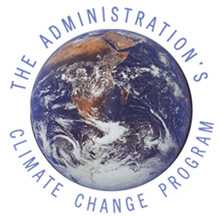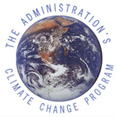|
OVERVIEW
- At a conference held October 25 - November 5, 1999, in Bonn,
Germany,
the Parties to the UN Framework Convention on Climate Change agreed to
accelerate their efforts to turn the broad concepts of the Kyoto Protocol
into working realities. Specifically, the Parties agreed to more than
double the time devoted to negotiations during the next year. This raises
considerably the prospects that the Parties will meet their deadline of
completing work on the key aspects of the operational framework of the
Protocol at next year's conference at The Hague, Netherlands. The
Protocol commits developed countries to reduce emissions of the greenhouse
gases most scientists believe are causing global warming, and provides
innovative, market-based tools for achieving those reductions. [See box].
- The Parties at the Bonn conference (known also as the “Fifth
Session of
the Conference of the Parties” or “CoP-5”) also made
significant progress
toward fulfilling the program of work set forth last year in the Buenos
Aires plan of action. This progress spanned the full spectrum of
important substantive issues, from international emissions trading to
carbon sinks to compliance.
- CoP-5 saw additional forward momentum on developing country
participation in efforts to combat global warming, highlighted by
Argentina's announcement of an emissions target and Kazakhstan's request
for inclusion into Annex I of the Convention.
SUMMARY OF ACCOMPLISHMENTS
ACCELERATED NEGOTIATIONS
- At the urging of the United States and other Parties, the Conference
agreed to more than double the time devoted to negotiations during the
next year. Inter-sessional meetings of the subsidiary bodies to the
Convention will be held in both June and September. The Parties also
agreed to a series of technical workshops and, perhaps most importantly,
invested the President of the Conference with the authority to take any
additional steps necessary to ensure completion of the Buenos Aires plan
of action at CoP-6.
MARKET-BASED MECHANISMS
- The Parties continued to make progress on developing the rules and
guidelines for Kyoto's market-based mechanisms (emissions trading, joint
implementation, and the Clean Development Mechanism). Negotiators
reaffirmed their commitment to conclude work on all three mechanisms in
parallel at next year's meeting at The Hague. The Parties produced a
negotiating text embodying detailed proposals on issues critical to the
operation of each of mechanisms, including transparency in tracking
transfers of emissions units and measurement, reporting and verification
issues.
- The United States was an early and forceful advocate for the Kyoto's
market-based mechanisms. The decisions made at CoP-5 bring each of them a
step closer to a reality. The United States reiterated in Bonn that
cost-effective rules and guidelines on mechanisms are critical components
of any finished Kyoto product.
|
THE KYOTO PROTOCOL
In December, 1997, in Kyoto, Japan, some 160 countries reached an historic
agreement to cut greenhouse gas emissions in an effort to fight global
warming — one of the most profound environmental challenges of the
21st century.
The Kyoto Protocol includes binding emissions targets for developed
nations — 8% below 1990 emissions levels for the European Union; 7%
for
the United States; and 6% for Japan — as well as U.S. proposals for
flexible, market-based measures to ensure that these targets can be met in
a cost-effective manner. The key market-based provisions are:
- International emissions trading among nations with emissions
targets.
Under an emissions trading regime, countries or companies that find it
relatively expensive to reduce emissions may purchase additional emissions
units from those emitters that have more units than they need (because
they have already met their targets with room to spare). Trading
encourages reductions where they can be achieved at the lowest cost, thus
getting the world the most greenhouse gas reductions for each available
dollar, euro or yen.
- Clean Development Mechanism (CDM). Industrialized countries
will be
able to use certified emissions reductions from projects in developing
countries to contribute to their compliance with greenhouse gas reduction
targets.
- Joint implementation among developed countries. Countries with
emissions targets may get credit towards their targets through joint
project-based emissions reductions in other such countries.
The Protocol includes additional elements of flexibility:
- Emissions targets are to be reached over a five-year commitment
period.
The first commitment period will be 2008-2012. Allowing emissions to
be
averaged over a commitment period helps smooth out short-term fluctuations
due to economic performance or weather. Having a decade before the start
of the binding period will allow more time for companies to make the
transition to greater energy efficiency and/or lower carbon
technologies.
- Emissions targets include all six major greenhouse gases. This
will
provide more comprehensive environmental protection while lending
additional flexibility to nations and companies in meeting their
targets.
- Activities that absorb carbon, such as planting trees, can be used
as
offsets against emissions of greenhouse gases. Including these
so-called
&$147;carbon sinks” will encourage activities such as afforestation,
reforestation, and better forestry and agriculture conservation practices.
To enter into force, the Protocol must by ratified by at least 55
countries, accounting for at least 55 percent of the total 1990 greenhouse
gas emissions of developed countries. United States ratification will
require the advice and consent of the U.S. Senate.
|
SUMMARY OF ACCOMPLISHMENTS
CARBON SINKS
- The Parties endorsed a detailed work program to accelerate the
negotiations relating to the scope and use of carbon sink activities under
the Protocol. Specifically, the Parties clarified their intention to
complete work at CoP-6 relating to the definition of forestry activities
under Article 3.3 of the Protocol, as well as additional sink categories
under Article 3.4, such as those created by improved conservation and
management of forests, agricultural soils, and grasslands. This decision
will keep the work on sinks on a parallel track with other issues outlined
in the Buenos Aires plan of action and was a key U.S. objective going into
Bonn.
- In 1998, the Parties tasked the Intergovernmental Panel on Climate
Change (IPCC) &$151; an international body of over 2000 of the world's
leading
climate scientists and experts — with conducting a comprehensive
study of
land use, land-use change, and forestry activities. Once this report is
completed in the spring of 2000, the Parties will submit detailed
proposals on sink definitions and activities (by August 1, 2000), which
will then become the foundation for a negotiating text.
COMPLIANCE
- The Parties made good progress at CoP-5 toward a common
understanding of
the basic elements of an effective compliance system and agreed to a
workshop and other meetings to advance work on compliance.
- In a related matter, the United States successfully advanced
methodological work designed to ensure that national emissions inventories
can assist in determining compliance with the Protocol. Parties agreed on
the basic elements of national systems for emissions monitoring, as well
as on how to ensure the completeness and quality of emission inventories.
DEVELOPING COUNTRY PARTICIPATION
- Argentina became the first developing country to announce a binding
emissions target for the 2008-2012 time period, following through on its
promise to do so made at last year's conference in Buenos Aires. The
United States applauds Argentina's announcement and supports the
development of a process for international acceptance of Argentina's
target as soon as possible. The United States also supports Argentina's
call upon the Parties to create a way in which Argentina and other
developing countries that voluntarily adopt appropriate targets may
benefit from all the Kyoto mechanisms.
- Kazakhstan formally requested inclusion in Annex I of the UNFCCC.
Although the Parties deferred action on the request, Kazakhstan's action
clearly signaled its continued willingness to take on a binding emissions
target for the 2008-2012 time period.
- These actions signaled a continuing shift in the terms of the
international debate on developing country participation, first seen last
year in Buenos Aires. Greater engagement in Bonn on the part of
developing countries was evidenced in other areas as well, including
heightened enthusiasm on the part of many for the Clean Development
Mechanism and constructive participation in efforts to forge agreement on
emissions trading, joint implementation, sinks, compliance, and other key
issues.
- The United States called for a new high-level dialogue with
developing
countries to explore the full-range of market-oriented strategies that can
create sustainable development opportunities for developing countries that
voluntarily reduce their emissions. Climate change is a global problem
requiring a global solution. Thus, securing more meaningful participation
from key developing countries remains a top priority for the United
States. The Administration will continue a “full-court diplomatic
press”
in this area.
|



![]()